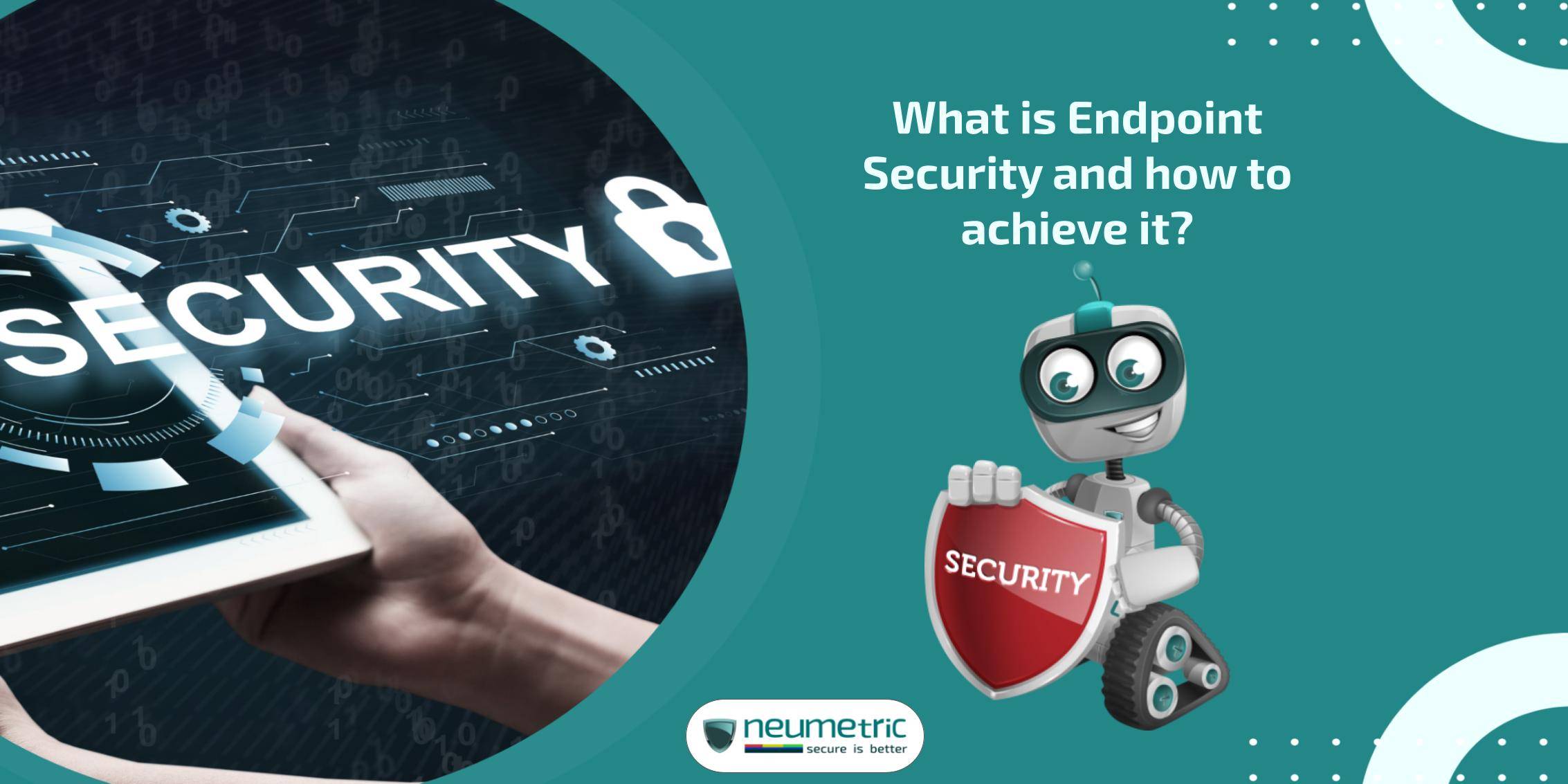Table of Contents
ToggleWhat is Endpoint Security and how to achieve it?
Introduction
Endpoint security refers to the protection of endpoints or devices that connect to a network, including computers, laptops, smartphones, tablets, servers & IoT devices. These endpoints serve as entry points for cyber threats, making them vulnerable to various attacks such as malware, phishing, ransomware & insider threats. Endpoint security aims to safeguard these devices from unauthorized access, data breaches & other malicious activities.
In today’s interconnected world, where remote work, BYOD [Bring Your Own Device] policies & cloud computing are commonplace, the importance of endpoint security cannot be overstated. With the proliferation of cyber threats targeting endpoints, organizations face significant risks, including financial losses, reputational damage & regulatory penalties. Moreover, the shift towards decentralized work environments has expanded the attack surface, making endpoint security a critical component of overall cybersecurity strategies.
This journal serves as a comprehensive guide to endpoint security, covering various aspects ranging from understanding endpoint security & its components to exploring common threats & best practices for achieving robust protection. By the end of this guide, you’ll have a clear understanding of how to safeguard your digital perimeter & mitigate the ever-evolving cyber threats targeting your endpoints.
Understanding Endpoint Security
Endpoints are the various devices that connect to a network, including computers, smartphones, tablets, servers & even IoT devices like smart thermostats or security cameras. Essentially, any device that can interact with the network is considered an endpoint. These endpoints are the frontline defenders of your digital assets, but they’re also the most vulnerable to cyber threats.
Think of endpoints as the gateways to your digital world. They’re the devices that enable you to access & interact with the internet, applications & other resources. From your work laptop to your smartphone & everything in between, endpoints are the conduits through which information flows in & out of your network. With the proliferation of remote work & mobile computing, the number & diversity of endpoints have skyrocketed, amplifying the importance of securing these devices.
Why Are Endpoints Vulnerable?
Endpoints are main targets for cybercriminals because to many factors:
- Diverse Ecosystem: Endpoints come in various forms & run on different operating systems, making them challenging to secure uniformly.
- Remote Access: With the rise of remote work, endpoints often operate outside the traditional perimeter of corporate networks, making them more susceptible to attacks.
- Human Factor: Endpoints are operated by humans who may inadvertently compromise security through actions like clicking on malicious links or downloading infected files.
- Constant Connectivity: Endpoints are continuously connected to the internet, increasing their exposure to threats such as malware, ransomware & phishing attacks.
The Evolution of Endpoint Security Solutions
As cyber threats have evolved, so too have endpoint security solutions. Initially, traditional antivirus software was the go-to solution for protecting endpoints against known malware. However, as cybercriminals developed more sophisticated attack methods, including zero-day exploits & polymorphic malware, traditional antivirus solutions became less effective.
In response, the field of endpoint security has advanced significantly, incorporating a range of proactive & reactive measures to detect, prevent & remediate threats. Modern endpoint security solutions leverage technologies such as behavioral analysis, machine learning [ML] & artificial intelligence [AI] to identify & mitigate both known & unknown threats in real-time.
Additionally, the shift towards cloud-based computing & the proliferation of mobile devices has necessitated the development of endpoint security solutions that can adapt to dynamic & decentralized environments. Today, endpoint security encompasses a holistic approach that combines antivirus protection, firewall capabilities, intrusion detection, encryption & endpoint detection & response [EDR] capabilities to provide comprehensive defense against evolving cyber threats.
Components of Endpoint Security
Protecting endpoints involves a multi-layered approach, utilizing various tools & technologies to defend against a wide range of cyber threats. Let’s explore some key components of endpoint security:
Antivirus & Anti Malware Software
Antivirus & Anti Malware software form the cornerstone of endpoint security by detecting & removing malicious software from endpoints. These solutions scan files & applications for known malware signatures & behavior patterns indicative of malicious activity. While traditional antivirus software focuses on known threats, next-generation anti-malware solutions employ heuristic analysis & machine learning [ML] algorithms to identify previously unseen malware.
Firewall Protection
Firewalls act as a barrier between endpoints & the internet, monitoring incoming & outgoing network traffic & blocking potentially harmful connections. They enforce access control policies, preventing unauthorized access to endpoints & filtering out malicious content such as malware & phishing attempts. Firewalls can be implemented at both the network level & the endpoint level to provide comprehensive protection.
Intrusion Detection Systems [IDS]
Intrusion detection systems [IDS] monitor network traffic for signs of unauthorized access, suspicious activities & known attack patterns. They analyze network packets in real-time, comparing them against predefined signatures & behavioral rules to identify potential security breaches. IDS can detect both external threats, such as malware & denial-of-service [DoS] attacks & internal threats, such as insider attacks & data exfiltration attempts.
Data Encryption
Data encryption safeguards sensitive information stored on endpoints by converting it into unreadable ciphertext that can only be decrypted with the appropriate encryption key. Endpoint encryption protects data-at-rest, ensuring that even if an endpoint is compromised, the data remains inaccessible to unauthorized users. Additionally, encryption protocols such as SSL/TLS secure data transmitted between endpoints & remote servers, protecting it from interception & tampering.
Endpoint Detection & Response [EDR]
Endpoint detection & response [EDR] solutions provide real-time monitoring, detection & response capabilities to protect against advanced threats & targeted attacks. EDR solutions collect & analyze endpoint telemetry data, identifying suspicious activities & potential security incidents. They enable security teams to investigate alerts, contain threats & remediate compromised endpoints, enhancing overall threat visibility & incident response capabilities.
Mobile Device Management [MDM]
Mobile device management [MDM] solutions allow organizations to control & protect mobile devices, including smartphones & tablets, that access corporate data & network. MDM solutions enforce security policies, such as device encryption, passcode requirements & application whitelisting, to mitigate the risks associated with mobile endpoints. They also enable remote monitoring, tracking & wiping of lost or stolen devices to prevent unauthorized access to sensitive information.
Common Endpoint Security Threats
In today’s digital landscape, endpoints face an array of threats that can compromise sensitive data, disrupt operations & undermine the integrity of systems. Let’s explore some of the most prevalent endpoint security threats:
Malware & Ransomware
Malware, short for malicious software, encompasses a broad category of malicious programs designed to infiltrate, damage or gain unauthorized access to endpoints. Ransomware, a specific type of malware, encrypts files or locks users out of their systems until a ransom is paid. These threats often spread through phishing emails, malicious downloads or compromised websites, posing significant risks to organizations’ data & operations.
Phishing Attacks
Phishing attacks involve tricking users into divulging sensitive information, such as login credentials or financial details, by masquerading as legitimate entities. Phishing emails, text messages or websites often employ social engineering tactics to deceive recipients into clicking on malicious links, downloading malware-infected attachments or providing confidential information. Phishing attacks can compromise endpoints & lead to data breaches, financial loss & identity theft.
Insider Threats
Insider threats originate from within an organization & involve employees, contractors or other trusted individuals intentionally or inadvertently compromising endpoint security. Insider threats may include malicious insiders seeking to steal sensitive data or sabotage systems, as well as negligent insiders who inadvertently expose sensitive information through careless actions such as clicking on phishing links or mishandling data.
Zero-Day Exploits
Zero-day exploits target vulnerabilities in software or hardware that are unknown to the vendor or have not yet been patched. Cybercriminals exploit these vulnerabilities to launch attacks on endpoints, bypassing traditional security measures & gaining unauthorized access to systems. Zero-day exploits pose significant risks to organizations, as they allow attackers to exploit vulnerabilities before patches or updates are available, leaving endpoints vulnerable to exploitation.
Advanced Persistent Threats [APTs]
Advanced persistent threats [APTs] are sophisticated, targeted attacks conducted by skilled adversaries with specific objectives, such as espionage, intellectual property theft or sabotage. APTs typically involve multiple stages & utilize advanced techniques to evade detection & maintain persistence within targeted endpoints & networks. These attacks often employ a combination of social engineering, malware & lateral movement to compromise endpoints & achieve their objectives over an extended period.
Best Practices for Achieving Endpoint Security
Protecting your endpoints requires a proactive & multi-faceted approach. Here are some best practices to enhance endpoint security:
Implementing a Layered Defense Approach
A layered defense strategy involves deploying multiple security measures across different layers of your IT infrastructure to provide comprehensive protection against a wide range of threats. This approach typically includes a combination of antivirus software, firewalls, intrusion detection systems, encryption & endpoint detection & response [EDR] solutions. By layering your defenses, you create multiple barriers that attackers must overcome, reducing the likelihood of successful breaches.
Keeping Software & Systems Updated
Regularly updating software & systems is critical for addressing known vulnerabilities & patching security flaws that could be exploited by attackers. Software updates often include security patches & bug fixes designed to address newly discovered vulnerabilities. Implementing automated patch management tools can help ensure that endpoints are promptly updated with the latest security patches, reducing the risk of exploitation by cyber threats.
Enforcing Strong Password Policies
Weak passwords are a common security vulnerability that can be easily exploited by attackers to gain unauthorized access to endpoints & sensitive data. Enforcing strong password policies, such as requiring complex passwords with a combination of letters, numbers & special characters, can help mitigate the risk of password-related attacks. Additionally, implementing multi-factor authentication [MFA] adds an extra layer of security by requiring users to verify their identity using multiple factors, such as a password & a one-time code (OTP) sent to their mobile device.
Conducting Regular Security Audits & Assessments
Regularly conducting security audits & assessments allows organizations to identify & address security weaknesses before they can be exploited by attackers. These audits may include vulnerability scans, penetration tests & security risk assessments to evaluate the effectiveness of existing security controls & identify areas for improvement. By proactively identifying & remediating security vulnerabilities, organizations can reduce the likelihood of successful cyber attacks & strengthen their overall security posture.
Educating Employees on Security Awareness
Employees are often the weakest link in the security chain, making security awareness training essential for mitigating human-related security risks. Educating employees about common cyber threats, such as phishing attacks & social engineering tactics, can help them recognize & respond appropriately to suspicious activities. Regular security awareness training sessions, phishing simulations & security reminders can empower employees to play an active role in protecting endpoints & safeguarding sensitive data.
Implementing Endpoint Security Solutions
Deploying dedicated endpoint security solutions, such as antivirus software, firewalls & endpoint detection & response [EDR] solutions, is essential for effectively protecting endpoints against a wide range of cyber threats. These solutions provide real-time threat detection, prevention & response capabilities, enabling organizations to proactively defend against malware, ransomware & other malicious activities. Additionally, endpoint security solutions should be regularly updated & configured to align with the organization’s security policies & requirements.
Conclusion
In the fast-paced world of cybersecurity, endpoint security stands as a critical line of defense against an ever-growing array of threats. As we conclude our exploration of endpoint security, let’s recap the key points & underscore the importance of prioritizing this vital aspect of cybersecurity.
Throughout this guide, we’ve covered a wide range of topics related to endpoint security, including:
- Understanding what endpoints are & why they’re vulnerable to cyber threats.
- Exploring the evolution of endpoint security solutions & the importance of adopting a multi-layered defense approach.
- Identifying common endpoint security threats such as malware, phishing attacks, insider threats, zero-day exploits & advanced persistent threats [APTs].
- Highlighting best practices for achieving robust endpoint security, including implementing a layered defense approach, keeping software & systems updated, enforcing strong password policies, conducting regular security audits & assessments, educating employees on security awareness & deploying dedicated endpoint security solutions.
Endpoint security is more critical than ever in today’s digital landscape, where cyber threats are constantly evolving & endpoints serve as prime targets for attackers. A breach or compromise of endpoint security can have far-reaching consequences, including data breaches, financial losses, reputational damage & regulatory penalties.
Prioritizing endpoint security is essential for:
- Protecting sensitive data: Endpoints often contain valuable information that, if compromised, can result in significant financial & reputational harm to organizations.
- Ensuring business continuity: A successful cyber attack on endpoints can disrupt operations, leading to downtime, lost productivity & revenue loss.
- Safeguarding customer trust: Maintaining strong endpoint security instills confidence in customers & stakeholders that their data is being handled securely & responsibly.
- Mitigating regulatory risks: Compliance with data protection regulations such as GDPR, HIPAA & PCI DSS requires organizations to implement robust endpoint security measures to protect sensitive data & maintain regulatory compliance.
In conclusion, prioritizing endpoint security is essential for safeguarding organizations’ digital assets, preserving business continuity & protecting against the ever-present threat of cyber attacks. By adopting a proactive & multi-layered approach to endpoint security & staying vigilant against emerging threats, organizations can mitigate risks, enhance their security posture & thrive in an increasingly connected & digital world.
Frequently Asked Questions [FAQ]
What are some common signs that my endpoint security may be compromised?
If you notice any unusual behavior on your devices, such as slower performance, unexpected pop-up windows or unfamiliar programs running in the background, it could indicate a security breach. Additionally, if you receive suspicious emails or messages asking for sensitive information or prompting you to download attachments or click on links, exercise caution as these could be phishing attempts. Regularly updating your security software & conducting scans for malware can also help detect & mitigate potential threats to your endpoint security.
How can I ensure that my employees are adequately trained to recognize & respond to security threats?
Educating employees on security awareness is crucial for strengthening your organization’s overall security posture. Implementing regular security training sessions covering topics such as identifying phishing emails, creating strong passwords & recognizing social engineering tactics can help employees recognize & respond to security threats effectively. Additionally, conducting simulated phishing exercises & providing ongoing reminders & updates on emerging threats can reinforce security awareness & promote a culture of cybersecurity within your organization.
With the rise of remote work & mobile computing, how can I secure endpoints that are outside the traditional perimeter of my corporate network?
Securing remote endpoints requires a comprehensive approach that extends beyond traditional network-based security measures. Implementing endpoint security solutions, such as antivirus software, firewalls & intrusion detection systems, on remote devices can help protect against malware, phishing attacks & other threats. Additionally, enforcing strong authentication mechanisms, such as multi-factor authentication [MFA] & encrypting data both at rest & in transit can help mitigate the risks associated with remote endpoints. Regularly updating software & systems, conducting security audits & assessments & providing ongoing security training to remote employees are also essential for maintaining robust endpoint security in a remote work environment.





